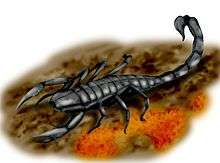Pulmonoscorpius
| Pulmonoscorpius | |
|---|---|
 | |
| Artist's rendition of Pulmonoscorpius | |
| Scientific classification | |
| Kingdom: | Animalia |
| Phylum: | Arthropoda |
| Subphylum: | Chelicerata |
| Class: | Arachnida |
| Order: | Scorpiones |
| Family: | †Centromachidae |
| Genus: | †Pulmonoscorpius Jeram, 1994 |
| Species: | †P. kirktonensis |
| Binomial name | |
| Pulmonoscorpius kirktonensis Jeram, 1994 | |
Pulmonoscorpius kirktonensis (literally lung scorpion) is a giant species of extinct scorpion[1] that lived during the Viséan age of the Carboniferous. Its fossils were found at East Kirkton Quarry, West Lothian in Scotland. In life, this species grew to 70 centimetres (28 in) long.[2] The diet of Pulmonoscorpius is not known directly, but smaller arthropods may have formed part of its diet, and its sting may have been able to fell small tetrapods.[3]
References
- ↑ Andrew J. Jeram (1998). "Phylogeny, classification and evolution of Silurian and Devonian scorpions". In Paul A. Selden. Proceedings of the 17th European Colloquium of Arachnology, Edinburgh 1997 (PDF). British Arachnological Society. pp. 17–31. ISBN 0-9500093-2-6. Archived from the original (PDF) on 2011-07-25.
- ↑ N. Scott Rugh. "Fossil Insects and Crustaceans. Armored beasts in the San Diego Natural History Museum's Paleontology Collection". San Diego Natural History Museum. Retrieved March 25, 2011.
- ↑ Jennifer A. Clack (2002). "East Kirkton and the roots of the modern family tree". Gaining Ground: the Origin and Evolution of Tetrapods. Life of the past. Indiana University Press. pp. 212–233. ISBN 978-0-253-34054-2.
External links
- https://web.archive.org/web/20061023072618/http://www.langsfossils.com/museum/pages/m-scld-002.htm
- http://dml.cmnh.org/1999Jun/msg00432.html
This article is issued from
Wikipedia.
The text is licensed under Creative Commons - Attribution - Sharealike.
Additional terms may apply for the media files.